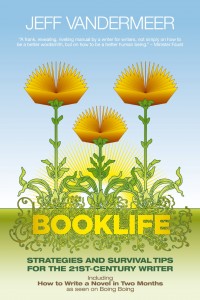Carrie Cuinn is a Author, editor, bibliophile, modernist, and geek. You can find her work online at carriecuinn.com and follow her on Twitter @carriecuinn.
When writing a story set in the present or the past, you already know what your options for language
are. You can write in the language of your expected readers, ignoring historical dialects so we can
clearly understand your meaning, or you can use words common to your characters’ time period to help
create a realistic atmosphere. Whether your story features an Old West gunfighter, a medieval farmer,
or a Roman poet, you can research the names of popular objects or slang terms the people might have
used.
When you’re writing the future, you have to make more choices. You need to balance realistically
portraying the time period with showing its difference from our time as well as making sure that the
story is still coherent to people reading it now. You need to think about who your speaker is, not just the people talking in the story but the person telling the story to your readers. You need to decide if you’re going to mix languages, create new words, adapt words we’re already using to make them sound futuristic… but how do you decide any of that?
The simplest solution to writing the future is to not do anything special at all. If you assume that your story is translated for modern readers even by some of the best E-word translation services, somehow taken from the your character’s language (whatever that may be) and put into 21st century English* then you don’t need to fake up your language. But there is a reason you may not want to take the simplest path: language can add to the setting of your story in a variety of ways, giving you a richer, more complex look at your invented future.
You can show the merger of two large cultures by including words from a non-English language mixed
in with your dialogue or even description, but – and I mean BUT – you have to be cautious. It’s terribly easy to slap on a few “exotic”** words and think you’re creating accessible multi-cultural characters but if you don’t know what the words mean or how language evolves over time, it sounds slapped on. It shows very quickly that you don’t know what you’re talking about. Mixing languages gives you a more honest feel, but that means you’ll either have phrases your readers don’t understand or you have to find a way to explain everything in context.
Firefly mixed Mandarin into the otherwise English dialogue. Joss Whedon didn’t give us subtitles (I should say I hoped subtitle translations would help me), and didn’t explain what was said, for the simple reason that the characters should have understood what was being said. There was no “outsider” to explain it to. It worked because they largely used Mandarin for swearing. So you didn’t need to know the exact translation, you just knew someone was angry. On the other hand, the first American version of Gojira, 1956’s Godzilla, King of the Monsters, mixed dubbed dialogue with the original Japanese, and added in a new character played by Raymond Burr, whose job was to be the outsider. He would yell, “What did he say?” and someone would repeat what had originally been said in Japanese.***
Firefly worked. Godzilla, King of the Monsters was a bit silly.
Another way to influence the setting with language is to create new brand names. We use brand names
as generic terms all of the time, once the object has become so common and has so many imitators that
the trademark can no longer be protected. We call that a generic trademark or a proprietary eponym.
It’s the reason you can ask someone to hand you a Kleenex or Band-Aid or a Thermos and they’ll know
what you’re talking about, even if what you’re asking for is actually produced by another company.
Inventing a proprietary eponym can be a way to show that changes have been made to technology
or commerce long enough ago that they were generalized into popular speech. Be careful that you’re
not creating a phrase you don’t need – I recently read a novel that used “Reefmail” instead of “email” because they lived on an artificial island. It was still mail, delivered electronically. The author described it as a fish swimming onto the computer screen, opening its mouth, and an envelope popping out. An envelope. So you know what it is. Then why call it something else?
Explore your options. Read over your work again. Out loud. Take out anything that feels unnecessary
or was inserted to sound exotic. Ask yourself, as many times as you need to, “why did I say it that
way?”
This is a just a beginning to the conversation about the possibilities of language in fiction. I hope that it gives you something to think about when you’re sitting down to write, or edit, your next great futuristic story.
* English is used as an example because that’s the language this post is written in. Of course, you
should use the language of your expected readers.
** If you’re hoping to create “exotic” characters you need to take a step back and consider a lot more than language. Simply put, something is only exotic because it is different than you, and different isn’t negative. A person isn’t more interesting or more sexual or more attractive or less anything just because they come from a different culture or the color of their skin is different. But you knew that already, right?
** While technically not set in the future, it is an alternate-Earth science fiction story, and illustrates
the example well.
Carrie Cuinn has written a follow up post here.
